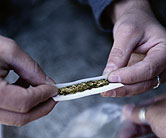
TUESDAY, Feb. 4, 2014 (HealthDay News) — The legalization of marijuana is an idea that is gaining momentum in the United States, but there may be a dark side to pot becoming more commonplace, a new study suggests.
Fatal crashes involving marijuana use tripled during the previous decade, fueling some of the overall increase in drugged-driving traffic deaths, researchers from Columbia University’s Mailman School of Public Health report.
“Currently, one of nine drivers involved in fatal crashes would test positive for marijuana,” said co-author Dr. Guohua Li, director of the Center for Injury Epidemiology and Prevention at Columbia. “If this trend continues, in five or six years non-alcohol drugs will overtake alcohol to become the most common substance involved in deaths related to impaired driving.”
The research team drew its conclusions from crash statistics from six states that routinely perform toxicology tests on drivers involved in fatal car wrecks — California, Hawaii, Illinois, New Hampshire, Rhode Island and West Virginia. The statistics included more than 23,500 drivers who died within one hour of a crash between 1999 and 2010.
Alcohol contributed to about the same percentage of traffic fatalities throughout the decade, about 40 percent, Li said.
But drugs played an increasingly prevalent role in fatal crashes, the researchers found. Drugged driving accounted for more than 28 percent of traffic deaths in 2010, up from more than 16 percent in 1999.
Marijuana proved to be the main drug involved in the increase, contributing to 12 percent of 2010 crashes compared with 4 percent in 1999.
The study authors also noted that the combined use of alcohol and marijuana dramatically increases a driver’s risk of death.
“If a driver is under the influence of alcohol, their risk of a fatal crash is 13 times higher than the risk of the driver who is not under the influence of alcohol,” Li said. “But if the driver is under the influence of both alcohol and marijuana, their risk increases to 24 times that of a sober person.”
The researchers found that the increase in marijuana use occurred across all age groups and in both sexes. Their findings were published online Jan. 29 in the American Journal of Epidemiology.
Marijuana impairs driving in much the same way that alcohol does, explained Jonathan Adkins, deputy executive director of the Governors Highway Safety Association. It impairs judgment, affects vision and makes a person more distractible and more likely to take risks while driving.
“This study shows an alarming increase in driving under the influence of drugs and, in particular, it shows an increase in driving under the influence of both alcohol and drugs,” said Jan Withers, national president of Mothers Against Drunk Driving.
“MADD is concerned anytime we hear about an increase in impaired driving, since it’s 100 percent preventable,” Withers added. “When it comes to drugged driving versus drunk driving, the substances may be different but the consequences are the same — needless deaths and injuries.”
The movement toward marijuana legalization makes the findings of this study incredibly important to traffic safety officials, Adkins noted.
“It’s a wake-up call for us in highway safety,” Adkins said. “The legalization of pot is going to spread to other states. It’s not even a partisan issue at this point. Our expectation is this will become the norm rather than the rarity.”
The problem is, marijuana and drug use before driving does not have the same stigma surrounding it as drunk driving has gained over the years, he added.
“The public knows about drunk driving, but I don’t think they have awareness of drugged driving, so this is a huge issue,” Adkins said. “We need to alert the public that if you’ve used any type of substance, you should not get behind the wheel. We need to create that culture where, like drunk driving, it is not acceptable.”
Police also do not have a test as accurate and convenient as the breathalyzer for checking a driver’s marijuana intoxication during a traffic stop, Li said.
A test is available that uses a driver’s saliva to check cannabis levels, but it’s not as reliable and accurate as the Breathalyzer, and has not been widely adopted by the police, he said.
“In the case of marijuana, I would say in maybe five years or more you will see some testing method or technique that may not as accurate as the breathalyzer, but is more accurate than the testing devices we have today,” Li said.
More information
For more information on driving under the influence of marijuana, visit the Pew Charitable Trusts.
Copyright © 2025 HealthDay. All rights reserved.

